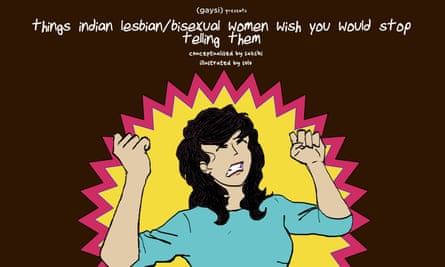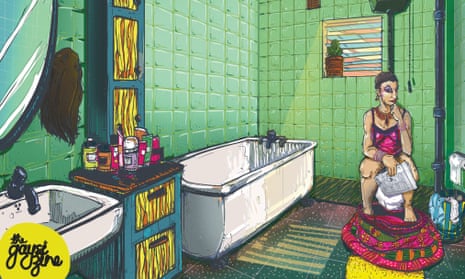The latest issue of the Gaysi zine sports a simple but striking cover in dark colours: a scattered collage of human forms, with the words “All That We Want” across it. Thumb through the magazine and you will find pieces of fiction, photo-essays, personal narratives, illustrations and how-to guides on the theme of sexual desire, from A Quick Guide to Scissoring to evocative verse on Love in the Age of Surveillance.
It is the sort of content that would not seem out of place in a gay zine published in Europe or the US, but in India it is positively subversive – and the first of its kind.
Gaysi – a portmanteau of the words gay and desi (desi is Hindi slang for south Asian) – first appeared as a blog almost 10 years ago. It has since developed a zine that retails at major bookshops across the country, hosts open mic events, book clubs and, most recently, India’s first drag king show. “We needed stories we could all relate to, and we needed an honest documentation of the lived realities of desi queer folks,” founder Sakshi Juneja explains.

Juneja began her journey online writing about gender and sexuality, among other things. Her interactions on queer female sites from other countries finally led to the creation of Gaysi, which runs opinion, news, interviews, book and theatre reviews and – the most popular – personal essays, often from those whose lives have been touched by the website. It is no surprise, then, that as well as queer sexuality, some of the most popular tags on this blog are “coming out”, “gay rights” and “homophobia”. The essays include personal expressions of difficult situations from those who feel confident about speaking out in this space – such as an article by a transgender woman and a letter from a queer woman to her mother.
Gaysi arrived at a time when there was no safe or open space in India for those who had come out, online or otherwise. Priya Gangwani, a regular contributor, remembers the first time she came across the blog, more than seven years ago. “I was 26 and had no vocabulary for gender and sexual minorities. I did not know any LGBTQ people, and the only queer term I was familiar with was homosexual, thanks to Virginia Woolf.”
“To be honest,” she says, “until I chanced on Gaysi, I thought I was the only one with these corrupted same-sex desires.” This was par for the course in most of India; even for educated and employed women such as the Gaysis, there were no sources of information, no conversations in the media. “It was as if queer people – especially LBT women – didn’t exist in India,” says Gangwani, while Juneja describes the community as being “silent and invisible”.
Today, Gaysi is managed by a core team of four women. There are a few regular writers – all of whom have day jobs, often in IT or marketing – but most of the content comes from female guest contributors from across the queer spectrum. This includes those still questioning and others who do not like to be labelled, and occasionally supportive and encouraging stories from parents and siblings.

It presents a vivid portrait of what it means to be queer in India, detailing battles inside and outside the home. A colonial law enforced by the British in 1860 ruled that homosexuality was illegal. In 2009, the law was overturned, but then in 2013 it was reinstated. This has resulted in a rise in moral policing on the streets, with gay people constantly looking over their shoulders. Thrown into the mix are hostile families who often condone “corrective treatments”, forced marriages, and sometimes even honour killings.
For Gangwani, “[Gaysi] was like discovering this new, magnificent, unimaginable and fascinating world. It completely blew my mind, and changed my life.”
Gaysi’s impact really widened when it expanded offline, into events where “queer women can be queer, either by themselves or with partners, without fear”. Now, they host two majoropen mic events a year and some kind of gathering at least once every couple of months, be it a trivia night or a badminton tournament for queer women. Gaysi’s visual content and design editor, who goes by the pseudonym Fishead, believes the work adds meaning to the lives of the creators and consumers. “This becomes even more urgent and relevant in these times, as we are working towards making sure that LGBTQI identities are never made invisible or silenced,” she says.

As expected, the 2013 ruling seems to have given this band of fiery women the zeal to make the Gaysi voice more open, powerful and inclusive.
In the past couple of years, several applications for performing at Gaysi open mic events have come from straight peoplewanting to express support for the gay community; now, even the mainstream media has started addressing queer issues. Things might look bleak on the legal scene, and social change may be slow in coming, but there is definitely an openness to thinking and talking about sexuality among Indians.
Young – and straight – people are more visible at LGBTQI activities in the bigger cities, and attend queer film festivals, gay pride marches and so on. The queer community is slowly taking physical form in the Indian eye; no doubt the women behind Gaysi will make this transformation quicker and easier.
